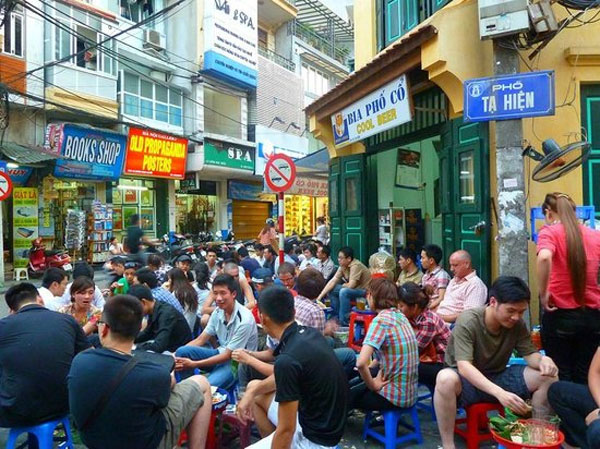What being a pedestrian means in Vietnam
 |
| Ta Hien Street Hanoi Old Quarter - Photo: tripadvisor.co.uk |
Rather than words of encouragement, they became a tool for intimidation when a Western man shouted at a Vietnamese girl riding her bike on a street in the Old Quarter, where motorbikes are banned from travelling between 7pm and 11pm on weekends.
The girl told another Vietnamese person that she had completely understood what the foreigner had said to her but explained, "I just didn't like it."
The pedestrian had continued to block her path until she eventually agreed to get off her bike and walk.
A video recording of the incident went viral overnight.
Most of the Vietnamese people posting on social networks completely supported the actions of the Western man since it was the girl who had invaded the pedestrian area, an action that is regarded as a bad habit.
One of my friends, an American teacher, later commented on Vietnamese etiquette in using the pavements: "Where does he think he lives? He is in Viet Nam."
This reminded me of the famous proverb, "When in Rome, do as the Romans do." Based on that concept, how would we define Vietnamese pavement etiquette?
"How do you cross the road in Ha Noi? Look left, look right, and you'll get hit by the guy riding on the pavement," Dominic Luxton, a visitor from London, said.
In crowded cities, instead of being stuck in traffic jams or squeezed on a bus, walking appears to be the choice offering the most freedom. In Viet Nam, however, walking isn't free of challenges.
"In Ha Noi, you can't walk on the pavement because of all the motorbikes parked on it, and I swear, in two days, I was nearly hit about 20 times," Samuel Crowley, an Englishman, said, recalling his visit to Ha Noi two years ago.
To most people, the "Vietnamese manner" likely conjures up images of parked motorbikes and streets jammed with vehicular traffic.
Mike Eveleigh, a traveller from America, said, "I realise that the pavement is purely for parking motorbikes, and the road is for walking, driving and cycling in whatever direction you fancy."
Indeed, the pedestrians can walk freely in any way they choose.
However, it is not just the motorbikes cluttering the pavements but also mobile street vendors selling fruit and vegetables and private shops that have expanded onto the pavements. In other words, public areas appear to be understood as public resources that anyone can make use of.
Ann Clarke, an expat working in Ha Noi for five years, said, "What a contrast: Ha Noi, where I can spit on the pavement, and Singapore, where I can lick it."
In fact, the development of the pavement economy in Ha Noi is closely related to the economic liberalisation process introduced by the Doi Moi (renewal) policy. As the number of job opportunities in the state's public sector dropped, a large number of former state employees decided to get involved in the pavement economy as a means of supplementing their income.
Images of street vendors elicit feelings of nostalgia for years past in Ha Noi. Architect Ton Dai, chairman of the Ha Noi Elder Architects Association, stressed that trading on pavements in the Old Quarter maintains a link between the past and the present.
"We need to keep the spirit of old streets alive as it is a unique feature of Vietnamese urban culture."
That brings us to the question of what residents want their city to look like.
Last month, the "Walking Visionaries Awards" for 2015-2020 was held in Hoi An by Walk21 Vienna for the Planning and Design for Liveable Public Spaces initiative, and the submitted project for Hoi An was highly praised.
Nguyen Van Son, vice president of Hoi An People's Committee, noted that the development of liveable public spaces was an urgent issue in urban areas. The global trend of urban development is to reconstruct the city in a manner that is healthy for its residents and provides room for walking and cycling.
Before its pedestrian zones came into effect in 2004, it took Hoi An four years to get the nod from both visitors and locals.
Last year, Quang Nam Province received nearly 3.7 million visits to Hoi An, and tourism authorities there have announced that Hoi An's pedestrian zone will be expanded and the hours of operation will be extended.
On August 11, the HCM City People's Committee requested Nguyen Hue Pedestrian Street's management team to ban pets from the pavements. The ban also included selling coffee, skating and sitting on picnic blankets on the sides of the street. In addition, HCM City installed hundreds of security cameras on Nguyen Hue Pedestrian Street to identify and penalise those who drive through walking zones.
Although Viet Nam recently granted visa-free travel to visitors from five European countries to revive its tourism industry, further steps are needed to boost the quality, not merely the appearance, of the streets.
For now, it is likely that clashes between foreigners and locals will continue to take place. And some people may even need to learn how to walk.
What the stars mean:
★ Poor ★ ★ Promising ★★★ Good ★★★★ Very good ★★★★★ Exceptional
Latest News
More News
- The tourism industry tackles plastic waste (January 03, 2025 | 16:24)
- Tourists flood in as Phu Quoc booms (January 02, 2025 | 10:36)
- US Magazine: A 3-Day trip to Phu Quoc costs less than a weekend in Singapore (December 27, 2024 | 17:19)
- Phu Quoc expects to welcome 1 million foreign travellers in 2025 (December 19, 2024 | 16:14)
- Vietnam among top 3 destinations appealing to Australians (December 19, 2024 | 16:09)
- Hanoi’s tourism boom: Over 25 million visitors and counting (December 10, 2024 | 17:57)
- Hanoi to strengthen presence on global tourism map (December 06, 2024 | 11:49)
- Hanoi’s new opera house to become a cultural landmark (December 05, 2024 | 18:12)
- Potential for retirement tourism in Vietnam (December 04, 2024 | 10:47)
- New opportunities for cultural tourism (December 04, 2024 | 10:40)















 Mobile Version
Mobile Version